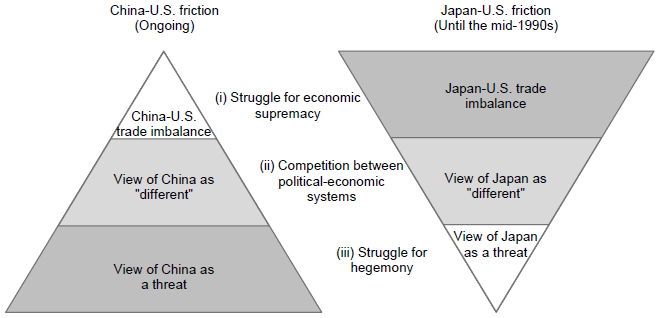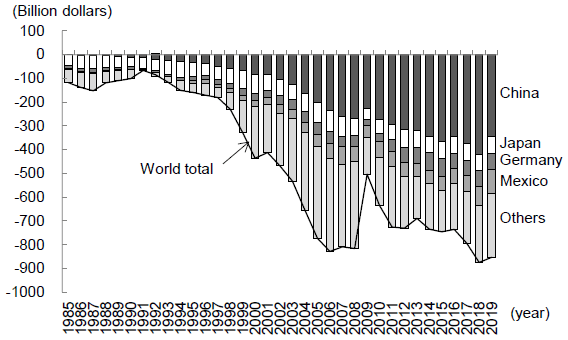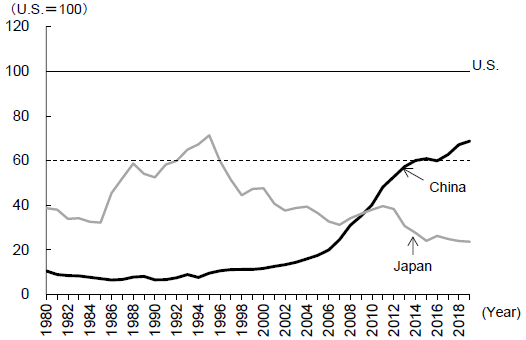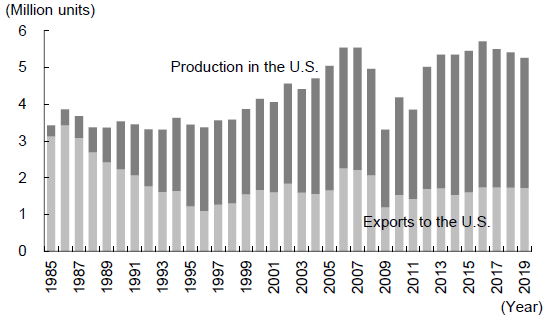The China-U.S. friction, which has intensified since the advent of the Trump administration in 2017, is reminiscent of the Japan-U.S. friction that continued until the middle of the 1990s. Factors common to both of these frictions include a "struggle for economic supremacy" as symbolized by the trade imbalance, a "competition between political-economic systems" as epitomized by the view of the opponent as "different," and "a struggle for hegemony" as exemplified by the view of the opponent as a threat. However, there is a significant difference between these two frictions in terms of how important those factors are relative to one another (Figure 1). In the case of the Japan-U.S. friction, although the view of Japan as different and as a threat surfaced, the central issue was always the trade imbalance. In contrast, in the case of the China-U.S. friction, the focus of attention is already shifting from the trade imbalance to the view of China as different and as a threat.

Comparison between the China-U.S. and Japan-U.S. Trade Imbalances
Since 2000, China has replaced Japan as the largest trade deficit source country for the United States. (Figure 2). In 1991, the U.S. deficit with Japan accounted for 65.5% of the overall U.S. trade deficit with the rest of the world, but in 2019, the Japanese share was down to 8.1% due to such factors as a shift from exports from Japan to local production in the United States in the automobile industry (See Box). Meanwhile, in 2019, the U.S. deficit with China made up as much as 40.5% of the overall U.S. trade deficit (the Chinese share peaked at 49.3% in 2015).

The U.S. trade imbalance has consistently reflected domestic excess consumption (with domestic savings falling short of investment). On the other hand, China is in a state of excess savings (with domestic savings exceeding domestic investment), as Japan was at the time of its friction with the United States. In the United States, capital flows from abroad (borrowings mainly from Japan in the past and from China now) are used to cover the trade deficit so that excess consumption can be maintained.
On the other hand, there are also differences between the China-U.S. and Japan-U.S. frictions.
First, in the case of the Japan-U.S. friction, both countries were developed countries and were engaging in fierce competition in many industries, including the auto industry, as there was already a competitive relationship between their economic structures. Conversely, at present, the economic structures of the United States and China are complementary to each other. The United States imports consumer goods with relatively low value added from China and exports aircraft and other capital goods with relatively high value added in exchange. While a competitive relationship tends to result in a zero-sum game, a complementary relationship is likely to lead to a win-win situation.
Moreover, while most exports from Japan to the United States were shipments by Japanese companies, a large portion of exports from China to the United States are shipments by U.S. and other foreign companies operating in China. Thus exports from China to the United States include a wide range of "reverse imports" by U.S. companies. Given this situation, the China-U.S. trade friction is not only a conflict of interest between the two countries, but it may also be regarded as an aspect of internal friction within the United States. This means that there are many U.S. companies whose interests are aligned with China's interests and which are opposing the hardline measures taken against China.
The presence of many U.S. companies benefiting from trade with China should work as a factor mitigating the China-U.S. friction. Therefore, unlike in the case of the Japan-U.S. friction, the trade imbalance is not necessarily the main focus of the China-U.S. confrontation.
Comparison between the Views of China as Different and Japan as Different
The view of China as different and the view of Japan as different are the same in that China is regarded as an unfair competitor that does not observe market rules, just as Japan was, but there are also differences between the two. The view of Japan as different was limited to the economic sphere, whereas the view of China as different extends to the realms of the political system and ideology as well.
The main thrust of the view of Japan as different can be surmised from the following six U.S. demands presented to Japan under the Japan-U.S. Structural Impediments Initiative (the final report issued in June 1990).
- (i) Expand public investment in order to improve the balance between savings and investment in Japan.
- (ii) Improve the market mechanism by correcting market distortions symbolized by differences between domestic and foreign prices.
- (iii) Improve the distribution system, including by revising the Large-Scale Retail Store Law.
- (iv) Correct high land prices by improving land policies.
- (v) Correct the closed nature of the Japanese market that stems from keiretsu relationships.
- (vi) Correct exclusionary business practices, including monopolies.
On the other hand, the view of China as different in the economic sphere is typified by the following U.S. criticisms against China's alleged failure to fully deliver on the pledges that it made when it joined the World Trade Organization (WTO) (Note 1).
- (i) While advocating a market economy, China is continuing interventions in the market by the government and the Communist Party.
- (ii) China exercises control over the allocation and prices of resources (land, labor, energy and capital) through government directives.
- (iii) China is strengthening the control of state-owned enterprises by the Communist Party and the government.
- (iv) The government is implementing industrial policies, including the Five-Year Plan and "Made in China 2025" and providing subsidies to particular industries and companies.
- (v) The protection of intellectual property rights by the government still remains inadequate.
On the confrontation between the United States and China over the political system and ideology, U.S. Secretary of State Mike Pompeo, delivering a speech at the Richard Nixon Presidential Library and Museum in California on July 23, 2020, upheld the view of China as different, saying that China cannot be treated as a "normal country (Note 2). The crux of his argument was that the regime under the Chinese Communist Party is based on Marxist-Leninist ideology and that Secretary General Xi Jinping, who is a believer in totalitarianism, has for many years had a desire for global hegemony. From that perspective, Secretary of State Pompeo said that the United States can no longer ignore the political and ideological differences between the two countries and stressed the need for a regime change in China by asserting: "If the free world doesn't change – doesn't change, communist China will surely change us."
Comparison between the Views of China as a Threat and Japan as a Threat
In the United States, the view of Japan as a threat was prevalent in the 1980s and the 1990s, but it has now been replaced by the view of China as a threat. While the view of Japan as a threat was limited to the field of economy, the view of China as a threat has extended to the realms of ideology and national security.
The United States' true objective in waging the trade war, as China understands it, is to contain China, which is challenging American hegemony. A column in the People's Daily, considered to be the official mouthpiece of the Chinese government, asserted that there is a "60% rule" for U.S. foreign policy (Note 3). Whenever a country has reached 60% of the United States in economic size and continues to grow, thereby threatening to surpass the U.S. economy, the United States views it as a rival and uses every possible measure to knock it out, according to the "60% rule" theory. China is rapidly catching up with the United States as the second largest economy in the world, as Japan was doing until the mid-1990s. In 1995, when the yen appreciated rapidly, Japan's GDP surpassed 70% of U.S. GDP, while China's GDP in 2019 was 68.7% of U.S. GDP. China has now become a target to be suppressed, just as Japan had some thirty years ago (Figure 3).

During the bubble-economy era in the late 1980s, not only did Japan's GDP expand rapidly (particularly on a dollar-denominated basis), with its per-capita GDP overtaking the U.S. level, but also Japanese stock and real estate prices surged ahead. It was said that the total value of the land in Tokyo's 23 wards was higher than the value of the land in the whole of the United States. In the market capitalization rankings of global companies in 1989, Japanese companies occupied 32 of the top 50 positions (Note 4). Thanks also to the yen's sharp appreciation, "Japan money" swept through the global financial market. Japan's economic strength was epitomized by Sony's takeover of Columbia Pictures (September 1989) and Mitsubishi Estate's acquisition of Rockefeller Group. In response to Japan's rise as an economic superpower, the view of Japan as a threat started to be frequently mentioned in U.S. media reports. According to the results of a poll of American citizens published by BusinessWeek (August 7, 1989 issue), a U.S. business magazine, 68% of respondents replied that Japan's economic power was a greater potential threat to the United States than the Soviet military power.
In those days, the view of Japan as a threat focused mainly on economic matters, whereas at present, the United States regards China as a threat in terms of ideology and national security as well. Specifically, the "United States Strategic Approach to the People's Republic of China," announced by the White House on May 20, 2020, stated on that point as follows (Note 5).
On ideology, China is challenging the bedrock American belief in the unalienable right of every person to life, liberty, and the pursuit of happiness. China has started to assert that the "system of socialism with Chinese characteristics" is superior to the Western system. Through the development and improvement of this socialist system, China is promoting the building of a "community of common destiny for mankind," is intervening in other countries' internal affairs, and is expanding its international influence by using media propaganda and other means.
On national security, in recent years, the Chinese military power's rapid growth and Chinese military activities have posed a significant threat to the interests of the United States and its allies and partners and undermined global businesses and supply chains. To be more specific, first, China is engaging in provocative and coercive military and paramilitary activities in the Yellow Sea, the East and South China Seas, the Taiwan Strait, and Sino-Indian border areas. Next, through its Military-Civil Fusion strategy, China is enhancing the People's Liberation Army's capability to develop advanced technology. China is also trying to bring the global information and communication technology industry under its control. The Chinese government is collecting foreign data in cooperation with Huawei and ZTE based on the National Cyber Security Law, according to the White House report.
From the abovementioned perspective, the report argued that the United States should continue to put pressure on China, resist and counter the threat from China in cooperation with its allies and partners, and protect American interests.
Can A Worst-Case Scenario Be Avoided?
Unlike China, whose confrontation with the United States over ideologies, political-economic systems and national security has become conspicuous, Japan, which belongs to the Western bloc of democracies and is an U.S. ally, does not pose a threat to the United States over those matters. That is why the Japan-U.S. friction always focused on economic matters and why it subsided as the Japanese economy remained stuck in a prolonged period of stagnation after the mid-1990s following the bursting of economic bubbles and as the trade imbalance between the two countries became relatively small. In contrast, the China-U.S. friction has become more than just a struggle for economic supremacy, increasingly developing into a competition between political-economic systems and a struggle for global hegemony. As a result, the room for compromise between the two sides is small, so resolving their confrontation seems difficult.
Under the Trump administration, the United States started its trade war with China, raising concerns that the two countries could stumble toward Thucydides's Trap (the situation of a struggle for hegemony between an emerging country and an existing superpower resulting in military conflict) (Note 6). Whether this worst-case scenario will be avoided through a peaceful resolution of the China-U.S. confrontation will be the test of the wisdom of the new U.S. administration under President Biden.
BOX Shift to Local Production as a Factor Reducing Japan's Surplus with the United States
One of the factors that curbed the trade imbalance between Japan and the United States from 1990 onward was that Japanese automakers reduced exports from Japan while increasing local production through direct investment in the United States (Figure). The volume of automobile exports from Japan to the United States, which peaked at 3.434 million units in 1986, was down to almost half that level, or 1.726 million units, in 2019. On the other hand, the volume of automobiles produced in the United States by Japanese automakers increased from 426 thousand units to 3.531 million units over the same period (the volume peaked at 3.976 million units in 2016). This means that around two-thirds of all Japanese automobiles sold in the United States in 2019 were locally manufactured ones.

Will China also be able to reduce its surplus with the United States by shifting from export to local production? The answer is negative. The source of China's export competitiveness is its relatively low wage level. However, if China moves production of labor-intensive products or processes, in which it has an advantage, to the United States, where the wage level is much higher, the advantage will be lost. Moreover, even if Chinese companies try to invest in the U.S. high-tech industry through corporate acquisitions and other means, such attempts will be rejected for national security reasons. If China is to use outward foreign investment as a means to resolve its friction with the United States, Vietnam and other developing countries, rather than the United States, are likely to become investment destinations. Indeed, at the time of the Japan-U.S. friction, Japan shifted production to Asian countries on a large scale following the yen's sharp appreciation and increased exports to the United States through overseas production bases.
The original text in Japanese was posted on January 7, 2021.


